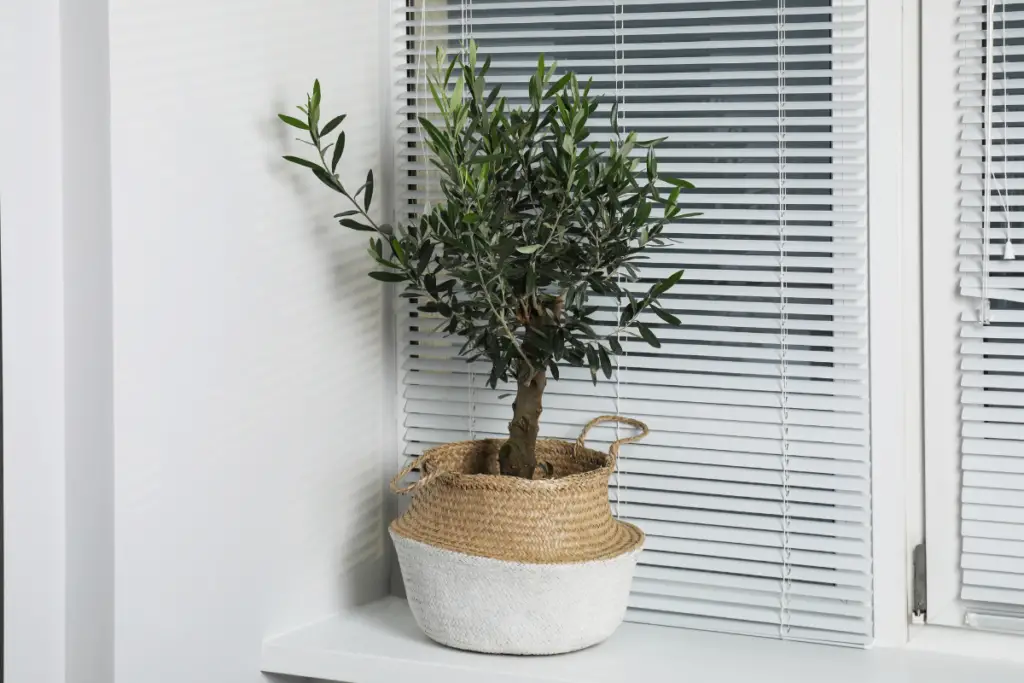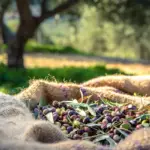Growing an olive tree indoors can be a unique and attractive addition to any home décor.
Olive trees are native to the warm Mediterranean region, but they can be grown indoors as a houseplant no matter where you live.
However, growing an olive tree indoors requires some specific care and attention.
To begin with, it’s important to choose the right location for your olive tree. Olive trees require plenty of bright, direct light to thrive, so it’s best to place them near a south-facing window or under a grow light.
However, be careful not to expose your olive tree to too much heat or direct sunlight, as this can cause the leaves to dry out and drop.
Additionally, olive trees prefer a room temperature between 65 and 80 degrees Fahrenheit and can withstand dry air, so keeping them in a heated room of up to 40% relative humidity is fine.
In this article, we will provide a comprehensive guide on how to grow and care for an olive tree indoors.
We will cover everything from choosing the right soil and pot to watering and fertilizing your olive tree.
With the right care and attention, you can enjoy the beauty and benefits of an olive tree in your home all year round.

Table of Contents
Understanding Olive Trees
Olive trees (Olea europaea) are evergreen trees that are native to the Mediterranean region. They are known for their slender, silver-green leaves and their small, edible fruit.
Olive trees can grow up to 50 feet tall, but they can also be grown as smaller indoor plants.
Olive trees are relatively easy to care for and are tolerant of dry air and dry soil, making them ideal for indoor environments.
They prefer a room temperature between 65 and 80 degrees Fahrenheit and can withstand relative humidity of up to 40%.
However, they should be kept away from heat vents and radiators to prevent drying out.
When growing olive trees indoors, it is important to choose a well-draining potting mix and a container with drainage holes.
Olive trees prefer soil that is slightly alkaline with a pH between 7 and 8.5. They should be watered thoroughly but allowed to dry out between waterings.
Olive trees also benefit from regular fertilization with a balanced fertilizer.
They can be pruned to maintain their shape and size, but it is important to avoid pruning too much as this can reduce fruit production.
With proper care, olive trees can live for many years and provide a unique and attractive addition to any indoor space.
Choosing the Right Olive Tree Variety
When it comes to growing an olive tree indoors, choosing the right variety is key. Some olive tree varieties are better suited for indoor growing than others.
Here are a few popular olive tree varieties to consider:
Arbequina
Arbequina is a popular olive tree variety that is well-suited for indoor growing. It is a small, compact tree that typically grows to be around 10 feet tall.
Arbequina olive trees produce small, flavorful olives that are perfect for eating or making olive oil.
This variety is also known for its attractive silver-green foliage, which can add a touch of elegance to any indoor space.
Picholine
Picholine is another olive tree variety that is well-suited for indoor growing. This variety is known for its high-quality olives, which are typically used for making olive oil.
Picholine olive trees are also quite attractive, with slender, silver-green leaves that can add a touch of sophistication to any indoor space.
Manzanillo
Manzanillo is a larger olive tree variety that can grow up to 30 feet tall. While this variety may not be the best choice for those with limited indoor space, it is a great option for those who want to grow a larger olive tree indoors.
Manzanillo olive trees produce large, juicy olives that are perfect for eating or making olive oil. This variety is also known for its attractive, dark green leaves.
When choosing an olive tree variety for indoor growing, it is important to consider factors such as size, fruit quality, and aesthetics.
By selecting the right variety, you can ensure that your indoor olive tree will thrive and produce delicious olives for years to come.
Optimal Indoor Conditions for Olive Trees
Growing olive trees indoors can be a unique and attractive addition to your home decor. However, it is essential to provide the optimal indoor conditions to ensure the tree’s health and longevity.
Light Requirements
Olive trees require at least six hours of direct sunlight per day. A large south-facing window is the only indoor location that can provide the necessary sun exposure.
Make sure the leaves do not touch the window glass, which can cause them to become scorched. To ensure equal light exposure on all sides, turn the pot 90 degrees every week.
If the olive tree does not receive enough sunlight, it can become weak and susceptible to pests and diseases.
In such cases, artificial lighting can be used to supplement natural light. Full-spectrum LED grow lights can provide the necessary light spectrum required for photosynthesis.
Temperature and Humidity
Olive trees prefer a warm, dry climate and can tolerate temperatures between 50°F and 85°F.
However, they are sensitive to sudden temperature changes and drafts. Keep the tree away from air conditioning vents, heaters, and doors that open frequently.
Maintain a moderate level of humidity around the tree. Olive trees prefer a dry environment, and high humidity can lead to fungal diseases.
Use a humidifier to increase humidity levels during the winter months when indoor heating can cause dry air.
Planting Your Olive Tree
When it comes to planting an olive tree indoors, there are a few key factors to consider.
This section will cover the two main sub-sections of planting your olive tree: choosing a pot and soil preparation.
Choosing a Pot
The first step in planting your olive tree is selecting the right pot. It is important to choose a pot that is large enough to accommodate the roots of the tree.
A pot that is too small may restrict root growth and hinder the growth of the tree. On the other hand, a pot that is too large may hold too much moisture, leading to root rot.
Ideally, the pot should be made of a porous material such as terra cotta, which allows for good drainage and aeration.
Additionally, the pot should have drainage holes to prevent water from accumulating in the bottom of the pot.
Soil Preparation
After selecting the appropriate pot, the next step is to prepare the soil. Olive trees prefer well-draining soil that is slightly alkaline, with a pH level between 7 and 8.
To achieve this, a mixture of potting soil and sand can be used.
Before planting the tree, it is important to moisten the soil to ensure it is evenly moist. The olive tree should be planted at the same depth it was growing in its previous container.
Once the tree is planted, gently firm the soil around the base of the tree to ensure it is stable.
Prices pulled from the Amazon Product Advertising API on:
Product prices and availability are accurate as of the date/time indicated and are subject to change. Any price and availability information displayed on [relevant Amazon Site(s), as applicable] at the time of purchase will apply to the purchase of this product.
Caring for Your Indoor Olive Tree
Growing an olive tree indoors can be a unique and attractive addition to your home decor. However, it requires proper care to thrive.
Here are some tips on how to care for your indoor olive tree.
Watering
Olive trees are drought-tolerant, but they still need to be watered regularly. Overwatering can lead to root rot, so it’s important to let the soil dry out between waterings.
The frequency of watering depends on the size of the pot, the size of the tree, and the humidity of the environment.
To check if the tree needs water, stick your finger into the soil about an inch deep. If it feels dry, it’s time to water.
When watering, make sure to water the entire root ball and let the excess water drain out of the bottom of the pot.
Fertilizing
Indoor olive trees don’t need to be fertilized as often as outdoor trees. Fertilize your tree once every three months during the growing season (spring and summer).
Use a balanced fertilizer with equal amounts of nitrogen, phosphorus, and potassium.
Avoid fertilizing during the winter months when the tree is dormant. Over-fertilizing can lead to salt buildup in the soil, which can harm the tree.
Pruning
Pruning is an important part of caring for an indoor olive tree. Prune your tree in the early spring before new growth appears.
Remove any dead or diseased branches, as well as any branches that are crossing or rubbing against each other.
To encourage bushier growth, pinch back the tips of the branches. This will also help to prevent the tree from becoming too tall and spindly.
By following these tips, you can ensure that your indoor olive tree stays healthy and beautiful.
Dealing with Pests and Diseases
Growing olive trees indoors can be a rewarding experience, but it is important to be aware of potential pests and diseases that can harm your plant.
Here are some common issues and solutions:
Pests
Scale: These pests suck sap from olive leaves, creating a yellow discoloration. To eliminate them, try soap and water or neem oil spray.
Spider Mites: These tiny pests can cause leaves to yellow and fall off. To prevent them, mist your olive tree regularly and keep the humidity levels up.
Mealybugs: These pests are small, white, and fluffy, and can cause leaves to turn yellow. To get rid of them, use rubbing alcohol or insecticidal soap.
Diseases
Fungal Leaf Spot: This disease causes brown spots on leaves. To prevent it, make sure your olive tree is not over-watered and has proper air circulation.
Verticillium Wilt: This disease causes leaves to wilt and turn yellow. Unfortunately, there is no cure for this disease, so it is important to remove infected plants and soil to prevent it from spreading to other plants.
Root Rot: This disease is caused by over-watering and can be prevented by ensuring proper drainage and not over-watering your olive tree.
By being aware of these common issues and taking preventative measures, you can keep your indoor olive tree healthy and thriving.
Moving Olive Tree Outdoors
Once the weather warms up, olive tree owners can move their potted trees outdoors. This can be a great way to give the tree a break from being indoors and allow it to soak up some natural sunlight.
Before moving the tree outdoors, it’s important to acclimate it slowly to the new environment.
Start by placing the tree in a shaded area for a few hours a day, gradually increasing the amount of time it spends in direct sunlight. This will help prevent the leaves from getting sunburned.
When choosing a spot for the olive tree, look for a location that gets plenty of sunlight and has well-draining soil.
If planting the tree in the ground, make sure to dig a hole that’s twice as wide as the root ball and just as deep.
Add some compost or other organic matter to the soil to help improve drainage and provide nutrients.
Water the tree regularly, but be careful not to overwater it. Olive trees are drought-tolerant and prefer to be on the dry side. Allow the soil to dry out slightly between waterings.
It’s also important to keep an eye out for pests and diseases. Olive trees can be susceptible to a variety of issues, including scale insects, spider mites, and fungal diseases.
Regularly inspect the tree for signs of damage and treat any problems promptly.
By following these tips, olive tree owners can successfully move their trees outdoors and enjoy fresh olives in the future.
Harvesting and Using Your Olives
Once your olive tree has matured, it will start producing fruit. The timing of the harvest depends on the variety of the tree and the desired ripeness of the olives.
Most olives are harvested in the fall, but some varieties can be harvested as early as September or as late as January.
To harvest your olives, gently pull them off the tree by hand or use a small rake to comb them off.
Be careful not to damage the tree or the fruit. Once you have harvested your olives, you can store them in a cool, dry place for a few weeks before using them.
Before using your olives, you will need to cure them to remove their bitterness. There are several ways to cure olives, including brine-curing, dry-curing, and water-curing.
Each method requires a different amount of time and effort, so choose the one that works best for you.
Once your olives are cured, you can use them in a variety of ways. Here are some ideas:
- Add them to salads or pasta dishes for a burst of flavor.
- Use them as a topping for homemade pizza.
- Make your own olive oil by crushing the olives and pressing out the oil.
- Use them to make tapenade, a delicious spread made with olives, capers, and anchovies.
- Enjoy them as a snack with a glass of wine or a cold beer.
Overall, growing an olive tree indoors can be a rewarding and enjoyable experience. With proper care and attention, you can harvest your own olives and enjoy them in a variety of ways.
Conclusion
In conclusion, growing an olive tree indoors is a rewarding experience that requires patience, attention to detail, and the right conditions.
With the right soil, lighting, watering, and pruning techniques, you can enjoy fresh olives and a beautiful tree in your home.
Remember to choose a suitable variety, such as Arbequina or Picholine, and to provide adequate drainage and humidity.
Be prepared to adjust your care routine based on the tree’s needs and to protect it from pests and diseases.
With these tips and a little bit of luck, you can successfully grow an olive tree indoors and enjoy the taste of the Mediterranean all year round.
- How to Dry Basil Leaves: A Professional Guide
- Is an Avocado a Fruit or Vegetable? Simple Answer and Explanation
- Does Pineapple Have Seeds? Exploring the Anatomy of Pineapples
- Blooming Through Winter: Can I Grow Vegetables Indoors in the Winter?
- What Can You Grow in a Greenhouse All Year Round: A Guide to Year-Round Greenhouse Gardening
- Are Blueberries Blue? Debunking the Myth of Their Color























